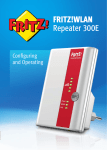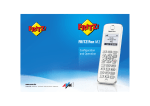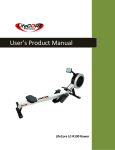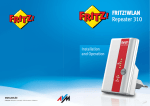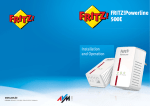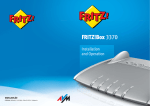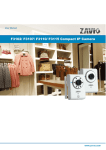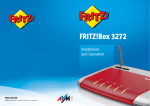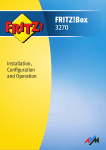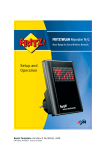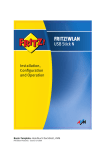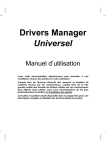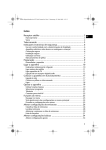Download FRITZ!WLAN USB Stick N
Transcript
FRITZ!WLAN USB Stick N Installation and Operation www.avm.de © AVM GmbH · Alt-Moabit 95 · 10559 Berlin · Telefon 030 39976-0 · [email protected] FRITZ!WLAN USB Stick N v2-e.fm Seite 2 Donnerstag, 13. Dezember 2012 4:14 16 Table of Contents Symbols and Highlighting . . . . . . . . . . . . . . . . . . . . . . . . 4 1 Safety Instructions . . . . . . . . . . . . . . . . . . . . . . . . . . . . . . 5 2 FRITZ!WLAN USB Stick N at a Glance . . . . . . . . . . . . . . . . 6 2.1 2.2 2.3 Package Contents . . . . . . . . . . . . . . . . . . . . . . . . . . . . . . . . . . . . . . . . 6 Operation Requirements . . . . . . . . . . . . . . . . . . . . . . . . . . . . . . . . . . . 6 LEDs . . . . . . . . . . . . . . . . . . . . . . . . . . . . . . . . . . . . . . . . . . . . . . . . . . . 7 3 Establishing a Wireless LAN Connection with Stick & Surf8 3.1 3.2 3.3 Prerequisite . . . . . . . . . . . . . . . . . . . . . . . . . . . . . . . . . . . . . . . . . . . . . 8 Transferring Security Settings to FRITZ!WLAN USB Stick . . . . . . . . . . 8 Connecting FRITZ!WLAN USB Stick to the Computer . . . . . . . . . . . . . 9 4 Establishing a Wireless LAN Connection Manually or with WPS . . . . . . . . . . . . . . . . . . . . . . . . . . . . . . . . . . . . . . . . . 11 4.1 4.2 Installing FRITZ!WLAN USB Stick in Windows . . . . . . . . . . . . . . . . . 11 Establishing a Wireless LAN Connection with Windows Wireless Service . . . . . . . . . . . . . . . . . . . . . . . . . . . . . . . . . . . . . . . . . . . . . . . . 13 5 Connecting Computers Directly (Ad-hoc Network) . . . . 18 5.1 5.2 5.3 Setting Up an Ad-hoc Network in Windows 7. . . . . . . . . . . . . . . . . . 18 Setting Up an Ad-hoc Network in Windows Vista . . . . . . . . . . . . . . 20 Setting Up an Ad-hoc Network in Windows XP. . . . . . . . . . . . . . . . . 21 6 The FRITZ!WLAN Software . . . . . . . . . . . . . . . . . . . . . . . . 25 7 Help in Case of Errors . . . . . . . . . . . . . . . . . . . . . . . . . . . 27 7.1 7.2 7.3 7.4 Errors During Installation. . . . . . . . . . . . . . . . . . . . . . . . . . . . . . . . . . 27 WLAN Connection Is Not Established . . . . . . . . . . . . . . . . . . . . . . . . 29 Errors during Data Exchange with Other Devices in the Network . . 30 Obtaining an IP Address Automatically . . . . . . . . . . . . . . . . . . . . . . 32 2 FRITZ!WLAN USB Stick N v2-e.fm Seite 3 Donnerstag, 13. Dezember 2012 4:14 16 8 Removing the FRITZ!WLAN USB Stick. . . . . . . . . . . . . . . 35 9 More about WLAN . . . . . . . . . . . . . . . . . . . . . . . . . . . . . . 36 9.1 9.2 9.3 Standards. . . . . . . . . . . . . . . . . . . . . . . . . . . . . . . . . . . . . . . . . . . . . . 36 Security. . . . . . . . . . . . . . . . . . . . . . . . . . . . . . . . . . . . . . . . . . . . . . . . 39 Frequency Ranges . . . . . . . . . . . . . . . . . . . . . . . . . . . . . . . . . . . . . . . 40 10 Technical Specifications. . . . . . . . . . . . . . . . . . . . . . . . . 43 11 Customer Service . . . . . . . . . . . . . . . . . . . . . . . . . . . . . . 44 11.1 11.2 11.3 11.4 11.5 Documentation . . . . . . . . . . . . . . . . . . . . . . . . . . . . . . . . . . . . . . . . . 44 Information in the Internet . . . . . . . . . . . . . . . . . . . . . . . . . . . . . . . . 44 Updates . . . . . . . . . . . . . . . . . . . . . . . . . . . . . . . . . . . . . . . . . . . . . . . 45 Support from the Support Team . . . . . . . . . . . . . . . . . . . . . . . . . . . . 45 Manufacturer’s Warranty . . . . . . . . . . . . . . . . . . . . . . . . . . . . . . . . . . 46 Legal Notice. . . . . . . . . . . . . . . . . . . . . . . . . . . . . . . . . . . 47 Legal Notice . . . . . . . . . . . . . . . . . . . . . . . . . . . . . . . . . . . . . . . . . . . . 47 Declaration of CE Conformity . . . . . . . . . . . . . . . . . . . . . . . . . . . . . . 48 Disposal Information . . . . . . . . . . . . . . . . . . . . . . . . . . . . . . . . . . . . . 49 Index . . . . . . . . . . . . . . . . . . . . . . . . . . . . . . . . . . . . . . . . 50 3 FRITZ!WLAN USB Stick N v2-e.fm Seite 4 Donnerstag, 13. Dezember 2012 4:14 16 Symbols and Highlighting Symbols and emphasized text are used to mark certain information in this manual. Symbols This symbol marks useful hints and tips. This symbol indicates important instructions that must be observed to avoid malfunctions. Highlighting Highlighting Example Quotation marks designate elements in the user interface, path entries, and names of folders and files “Home Network” “C:\Pictures” “Info” Blue, underlined text designates addresses to be entered in the browser fritz.box Blue text designates links and references within this manual see page 47 Bold type emphasizes important words Do not click ... 4 FRITZ!WLAN USB Stick N v2-e.fm Seite 5 Donnerstag, 13. Dezember 2012 4:14 16 1 Safety Instructions When working with the FRITZ!WLAN USB Stick, follow the instructions below to protect yourself and the FRITZ!WLAN USB Stick from damage. • Do not install the FRITZ!WLAN USB Stick during an electrical storm. • Unplug the FRITZ!WLAN USB Stick from the computer during an electrical storm. • Never let liquids get inside the FRITZ!WLAN USB Stick. Otherwise, electric shocks or short circuits may result. • Protect the FRITZ!WLAN USB Stick from dust, moisture and steam. Clean the FRITZ!WLAN USB Stick with a slightly moist, lint-free cloth. Intensive cleaning products or solvents are not suitable. • • FRITZ!WLAN USB Stick is intended for indoor use only. Do not open the FRITZ!WLAN USB Stick housing. The device contains hazardous components and should only be opened by authorized repair technicians. 5 FRITZ!WLAN USB Stick N v2-e.fm Seite 6 Donnerstag, 13. Dezember 2012 4:14 16 FRITZ!WLAN USB Stick N at a Glance 2 FRITZ!WLAN USB Stick N at a Glance The FRITZ!WLAN USB Stick connects your computer easily and safely with your FRITZ!Box WLAN and other compatible WLAN access points: This grants the computer wireless access to the Internet. The FRITZ!WLAN USB Stick can also connect your computer directly with other computers (ad-hoc network). Then the computers can exchange data with each other without a wireless access point. Thanks to Stick & Surf technology, you can connect to a FRITZ!Box quickly and conveniently without making any settings on your computer. 2.1 Package Contents • • • 2.2 FRITZ!WLAN USB Stick N v2 USB docking station printed quick guide Operation Requirements In order to operate the FRITZ!WLAN USB Stick N, your computer must fulfill the following requirements: • • a free USB port (USB 2.0 or higher) Microsoft Windows 8/7 (32- or 64-bit edition), Windows Vista (32-bit edition) or Windows XP Service Pack 3 or higher (32-bit edition) operating system Installation of the latest service packs and updates is recommended. • Pentium-class computer or notebook (500 MHz CPU or better) • at least 64 MB RAM and 5 MB free memory on the hard drive 6 FRITZ!WLAN USB Stick N v2-e.fm Seite 7 Donnerstag, 13. Dezember 2012 4:14 16 LEDs 2.3 LEDs LED Condition Meaning USB green The FRITZ!WLAN USB Stick was detected by the operating system. WLAN flashes yellow The FRITZ!WLAN USB Stick is exchanging data with another wireless device. 7 FRITZ!WLAN USB Stick N v2-e.fm Seite 8 Donnerstag, 13. Dezember 2012 4:14 16 Establishing a Wireless LAN Connection with Stick & Surf 3 Establishing a Wireless LAN Connection with Stick & Surf With Stick & Surf you can establish a secure wireless connection to your FRITZ!Box quickly and conveniently. You do not have to make any settings on the computer. When you use the FRITZ!WLAN USB Stick on the computer for the first time, the device drivers are installed automatically. 3.1 Prerequisite You can use Stick & Surf with every FRITZ!Box that has a port for USB devices. For instructions about establishing wireless LAN connections to other WLAN access points, read from page 11. 3.2 Transferring Security Settings to FRITZ!WLAN USB Stick First transmit the wireless LAN security settings of the FRITZ!Box to the FRITZ!WLAN USB Stick. The wireless LAN security settings are required on the FRITZ!WLAN USB Stick only in order to establish the wireless LAN connection; they will be deleted afterwards. 1. Insert the FRITZ!WLAN USB Stick into the USB port on your FRITZ!Box. / er w Po SL D z et n st Fe et rn te In N LA W fo In Inserting the FRITZ!WLAN USB Stick in the FRITZ!Box 2. The “Info” LED on the FRITZ!Box begins flashing. Wait until the “Info” LED stops flashing and remains lit up. 8 FRITZ!WLAN USB Stick N v2-e.fm Seite 9 Donnerstag, 13. Dezember 2012 4:14 16 Connecting FRITZ!WLAN USB Stick to the Computer 3. Remove the FRITZ!WLAN USB Stick from the FRITZ!Box. The WLAN security settings of the FRITZ!Box are now saved on the FRITZ!WLAN USB Stick. 3.3 Connecting FRITZ!WLAN USB Stick to the Computer Once the wireless LAN security settings have been transmitted to the FRITZ!WLAN USB Stick, connect it to your computer. 1. Start your computer. 2. Insert the FRITZ!WLAN USB Stick into a USB port on the computer. Connecting FRITZ!WLAN USB Stick to the computer 3. Windows detects the FRITZ!WLAN USB Stick automatically. When you insert the FRITZ!WLAN USB Stick in your computer for the first time, the device drive installation starts automatically. Continue with the next step. If the device driver is already installed, a wireless LAN connection between the computer and FRITZ!Box is established automatically. The Stick & Surf logo appears. Skip the next two steps. 4. In the “AutoPlay” window, click “FRITZ!WLAN USB Stick N v2 Installation”. This window does not always appear. In some versions of Windows the device driver installation is performed automatically without requiring any user intervention. 5. Confirm any questions asked during installation by clicking “Yes”, “Install” or “Continue”, for instance, the security prompt by Windows’ user account control. 9 FRITZ!WLAN USB Stick N v2-e.fm Seite 10 Donnerstag, 13. Dezember 2012 4:14 16 Connecting FRITZ!WLAN USB Stick to the Computer 6. After the device driver in installed, a wireless LAN connection between the computer and FRITZ!Box is established automatically. The Stick & Surf logo appears on the screen. Stick & Surf logo The wireless LAN connection has been established successfully when the FRITZ!WLAN icon in the Windows taskbar turns green. Every time the computer is started the connection is resumed automatically. For more information on the FRITZ!WLAN software,see page 25. 10 FRITZ!WLAN USB Stick N v2-e.fm Seite 11 Donnerstag, 13. Dezember 2012 4:14 16 Establishing a Wireless LAN Connection Manually or with WPS 4 Establishing a Wireless LAN Connection Manually or with WPS This section describes how to install the FRITZ!WLAN USB Stick on your computer and establish a wireless LAN connection to any wireless LAN access point. Depending on the features available on the wireless LAN access point, you either enter the wireless LAN security settings on the computer by hand, or establish the connection automatically with WPS. On a FRITZ!Box with a port for USB devices, it is easier to establish wireless LAN connections using Stick & Surf (see page 8). 4.1 Installing FRITZ!WLAN USB Stick in Windows The FRITZ!WLAN USB Stick can be installed in Windows 8/7 (32-bit and 64-bit), Windows Vista (32-bit) and Windows XP service pack 3 or higher (32-bit). 1. Start your computer. 2. Insert the FRITZ!WLAN USB Stick into a USB port on the computer. Windows will detect the device automatically. Connecting FRITZ!WLAN USB Stick to the computer 3. In the “AutoPlay” window, click “FRITZ!WLAN USB Stick N v2 Installation”. This window does not always appear. In some versions of Windows the device driver installation is performed automatically without requiring any user intervention. 11 FRITZ!WLAN USB Stick N v2-e.fm Seite 12 Donnerstag, 13. Dezember 2012 4:14 16 Installing FRITZ!WLAN USB Stick in Windows 4. Confirm any questions asked during installation by clicking “Yes”, “Install” or “Continue”, for instance, the security prompt by Windows' user account control. Installation of the device driver is complete when the message “Installation of the wireless LAN hardware has been completed successfully” appears. Message after successful installation of the device driver 12 FRITZ!WLAN USB Stick N v2-e.fm Seite 13 Donnerstag, 13. Dezember 2012 4:14 16 Establishing a Wireless LAN Connection with Windows Wireless Service 4.2 Establishing a Wireless LAN Connection with Windows Wireless Service Once you have installed the FRITZ!WLAN USB Stick, you can establish the wireless LAN connection using the Windows Wireless Networks Service. Establishing a wireless LAN connection in Windows 8 1. Move the mouse cursor to the upper right corner of the Start page and click “Settings”. 2. Click the wireless LAN icon . A list appears on the screen, showing all wireless networks (mostly WLAN access points) found in the vicinity of the FRITZ!WLAN USB Stick. Wireless networks in the vicinity of the FRITZ!WLAN USB Stick 3. Select a wireless LAN access point. Selected wireless LAN access point 13 FRITZ!WLAN USB Stick N v2-e.fm Seite 14 Donnerstag, 13. Dezember 2012 4:14 16 Establishing a Wireless LAN Connection with Windows Wireless Service 4. Click “OK”. The window for entering the wireless LAN key appears. If the wireless LAN connection can be established using WPS (the wireless LAN access point must support WPS), a note with the WPS icon will appear in the window. Window for entering the network key with reference to WPS 5. Enter the network key of the wireless LAN access point and then click “OK”. On a FRITZ!Box the network key is found on the base of the device housing. or If the WPS icon is displayed, click the button assigned for WPS on the wireless access point. The network key is transferred to the computer automatically. On a FRITZ!Box without a WPS button, press the “WLAN” button until the “WLAN” LED starts flashing. The WLAN connection will be established. Every time the computer starts the wireless LAN connection is resumed automatically. 14 FRITZ!WLAN USB Stick N v2-e.fm Seite 15 Donnerstag, 13. Dezember 2012 4:14 16 Establishing a Wireless LAN Connection with Windows Wireless Service Establishing a Wireless LAN Connection in Windows 7 / Windows Vista 1. Click the WLAN icon bar. or in the Windows task A list appears on the screen, showing all wireless networks (mostly WLAN access points) found in the vicinity of the FRITZ!WLAN USB Stick. Wireless networks in the vicinity of the FRITZ!WLAN USB Stick 2. Select a wireless LAN access point. Selected wireless LAN access point 3. Click “OK”. 15 FRITZ!WLAN USB Stick N v2-e.fm Seite 16 Donnerstag, 13. Dezember 2012 4:14 16 Establishing a Wireless LAN Connection with Windows Wireless Service The window for entering the wireless LAN key appears. If the wireless LAN connection can be established using WPS (the wireless LAN access point must support WPS), a note with the WPS icon will appear in the window. Window for entering the network key with reference to WPS 4. Enter the network key of the wireless LAN access point and then click “OK”. On a FRITZ!Box the network key is found on the base of the device housing. or If the WPS icon is displayed, click the button assigned for WPS on the wireless access point. The network key is transferred to the computer automatically. On a FRITZ!Box without a WPS button, press the “WLAN” button until the “WLAN” LED starts flashing. The WLAN connection will be established. Every time the computer starts the wireless LAN connection is resumed automatically. 16 FRITZ!WLAN USB Stick N v2-e.fm Seite 17 Donnerstag, 13. Dezember 2012 4:14 16 Establishing a Wireless LAN Connection with Windows Wireless Service Establishing a Wireless LAN Connection in Windows XP 1. Click the WLAN icon Windows task bar. in the notification area of the A list appears on the screen, showing all wireless networks (mostly WLAN access points) found in the vicinity of the FRITZ!WLAN USB Stick. Wireless networks in the vicinity of the FRITZ!WLAN USB Stick 2. Select a wireless LAN access point and click “Connect”. The window for entering the wireless LAN key appears. Window for entering the network key 3. Enter the network key of the wireless LAN access point twice and then click “OK”. The wireless LAN connection is established and resumed automatically every time the computer is started. On a FRITZ!Box the network key is found on the base of the device. 17 FRITZ!WLAN USB Stick N v2-e.fm Seite 18 Donnerstag, 13. Dezember 2012 4:14 16 Connecting Computers Directly (Ad-hoc Network) 5 Connecting Computers Directly (Ad-hoc Network) In a direct connection (also called an ad-hoc network), computers are connected with each other without the involvement of any wireless LAN access point like the FRITZ!Box. If you set up an ad-hoc network on a computer with the FRITZ!WLAN USB stick, other computers can register with the ad-hoc network. 5.1 Setting Up an Ad-hoc Network in Windows 7 1. Click the WLAN icon in the Windows task bar with the right mouse button. 2. Select “Open Network and Sharing Center”. The “Open Network and Sharing Center” option 3. On the left, click “Manage wireless networks”. 4. Click “Add”. The “Add” button 5. Select “Create an ad hoc network” and click “Next” in the following window. 6. Enter a network name. 18 FRITZ!WLAN USB Stick N v2-e.fm Seite 19 Donnerstag, 13. Dezember 2012 4:14 16 Setting Up an Ad-hoc Network in Windows 7 7. Select a wireless LAN encryption method (security type). WPA and WPA2 offer the highest security. For more information on the various wireless LAN encryption methods, click the “Need help deciding” link next to the “Security Type” drop-down list. 8. Enter a “Security key”. 9. The ad-hoc network is deleted automatically as soon as all participants clear the connection or the provider of the ad-hoc network clears all connections. Enable the “Save this network” option if the ad-hoc network should not be automatically deleted. 10. Click “Next”. The ad-hoc network is being configured and awaiting users. You see the ad-hoc network when you click the WLAN icon in the Windows task bar. Ad-hoc network waiting for users 19 FRITZ!WLAN USB Stick N v2-e.fm Seite 20 Donnerstag, 13. Dezember 2012 4:14 16 Setting Up an Ad-hoc Network in Windows Vista 5.2 Setting Up an Ad-hoc Network in Windows Vista 1. Click the “Start” button. 2. Click on “Connect” or “Establish Connection”. 3. Click on “Set up a connection or network”. The “Set up a connection or network” option 4. Select “Set up a wireless ad hoc (computer-to-computer) network” and click “Next”. The “Set up a wireless ad hoc network” option 5. Follow the wizard’s instructions. A wizard takes you step by step through the configuration of the ad-hoc network. 20 FRITZ!WLAN USB Stick N v2-e.fm Seite 21 Donnerstag, 13. Dezember 2012 4:14 16 Setting Up an Ad-hoc Network in Windows XP 5.3 Setting Up an Ad-hoc Network in Windows XP 1. Click the “Start” button and select “My Network Places”. If “My Network Places” is not available, open “My Computer” and click “My Network Places” under “Other Places”. 2. Click with the right mouse button in the free area in the “My Network Places” window. Select “Properties” from the context menu. Context menu in “My Network Places” 3. Click the “Wireless Network Connection / FRITZ!WLAN USB Stick” icon in the “Network Connections” window with the right mouse button. Select “Properties” from the context menu. 4. In the “Wireless Network Connection Properties” window, switch to the “Wireless Networks” tab. The “Wireless Networks” tab 5. Click the “Add...” button. 21 FRITZ!WLAN USB Stick N v2-e.fm Seite 22 Donnerstag, 13. Dezember 2012 4:14 16 Setting Up an Ad-hoc Network in Windows XP 6. Configure the following settings in the “Wireless network properties” window: Enable the option “This is a computer-to-computer (ad hoc) network; wireless access points are not used”. For “Network Authentication” select “Shared”. For “Data encryption” select “WEP”. Enter a 5-digit or 13-digit network key. The “Wireless Network Properties” window 7. Click “OK”. 22 FRITZ!WLAN USB Stick N v2-e.fm Seite 23 Donnerstag, 13. Dezember 2012 4:14 16 Setting Up an Ad-hoc Network in Windows XP Assigning IP Addresses to Participating Devices Windows XP does not provide a DHCP server that can assign dynamic IP addresses to the participants of the ad-hoc network. This means you have to assign fixed IP addresses to the participating devices. 1. Open the properties of the network connection “Wireless Network Connection / FRITZ!WLAN USB Stick” (see steps 1 - 3 in “Setting Up a New Ad-hoc Network”). 2. Select the “Internet Protocol (TCP/IP)” in the list of elements to be used. 3. Click the “Properties” button. 4. Enable the “Use the following IP address:” option. 5. On the computer that provides the ad-hoc network you can assign, for instance, the IP address 192.168.1.1 and the subnet mask 255.255.255.0. Assign to other computers participating in the ad-hoc network IP addresses between 192.168.1.2 and 192.168.1.9. Each IP address can be assigned only once. IP settings 23 FRITZ!WLAN USB Stick N v2-e.fm Seite 24 Donnerstag, 13. Dezember 2012 4:14 16 Setting Up an Ad-hoc Network in Windows XP If one of the computers in the ad-hoc network is connected with the Internet (for instance via LAN cable), you can enter the IP address of that computer on the other computers as the standard gateway to provide access to the Internet for all computers. If a DNS server is running on one of the computers in the adhoc network, you can enter the IP address of this computer as the “Preferred DNS server”. If no DNS server is available, enter any IP address. In this case you can reach other computers only by entering their IP addresses. Registering at an Ad-hoc Network The computer on which you set up the ad-hoc network still has to log in to the ad-hoc network. Only then is the ad-hoc network visible for other computers. 1. Click the WLAN icon Windows task bar. 2. Select the ad-hoc network and click “Connect”. in the notification area of the Now you can use the WLAN software on the other computers to search for and log in to the ad-hoc network. 24 FRITZ!WLAN USB Stick N v2-e.fm Seite 25 Donnerstag, 13. Dezember 2012 4:14 16 The FRITZ!WLAN Software 6 The FRITZ!WLAN Software The FRITZ!WLAN software is installed on your computer along with the FRITZ!WLAN USB Stick. FRITZ!WLAN offers you information on the wireless LAN connection and various settings for the FRITZ!WLAN USB Stick. The software is not required to establish wireless LAN connections. Starting FRITZ!WLAN Double-click in the Windows task bar on the FRITZ!WLAN icon FRITZ!WLAN starts. The “Connection Monitor” tab is active. Program Interface 1: Tabs 2: “Help” button to open the Online Help 25 . FRITZ!WLAN USB Stick N v2-e.fm Seite 26 Donnerstag, 13. Dezember 2012 4:14 16 The FRITZ!WLAN Software Information and Settings on the Tabs The following information and settings are found on the “Connection Monitor”, “Connection Details” and “Properties” tabs: Tab Information / Settings Connection Monitor • information on the quality of the wireless LAN connection • a wireless LAN test to test and improve the wirelss LAN connection Connection Details Properties various data on the wireless LAN connection and the wireless LAN devices involved, e.g.: • WLAN key • wireless LAN channel • throughput rates • the IP address and the MAC address of the FRITZ!WLAN USB Stick • various settings for the FRITZ!WLAN USB Stick, for instance for transmitter power Online Help The FRITZ!WLAN includes a comprehensive Online Help with additional information on the software. The Online Help can be opened on any tab by clicking the “Help” button. 26 FRITZ!WLAN USB Stick N v2-e.fm Seite 27 Donnerstag, 13. Dezember 2012 4:14 16 Help in Case of Errors 7 Help in Case of Errors This chapter presents assistance for problems that arise during installation, while establishing the wireless LAN connection, or during data exchange with other devices in the network. 7.1 Errors During Installation No FRITZ!WLAN Icon in the Windows Task Bar The FRITZ!WLAN icon is not displayed in the Windows task bar. Cause The FRITZ!WLAN USB Stick was not installed correctly or is disabled in the Windows Device Manager. Help Check whether the FRITZ!WLAN USB Stick is displayed in the Windows Device Manager and make sure it is enabled. If the device is disabled, enable it. If the device is not displayed, uninstall the FRITZ!WLAN USB Stick (see page 35) and remove it from the USB port of the computer. Then work through the steps from one of the following sections again: Establishing a Wireless LAN Connection with Stick & Surf on page 8 or Establishing a Wireless LAN Connection Manually or with WPS on page 11. The FRITZ!WLAN USB Stick will be re-installed. 27 FRITZ!WLAN USB Stick N v2-e.fm Seite 28 Donnerstag, 13. Dezember 2012 4:14 16 Errors During Installation The Computer Does Not Detect FRITZ!WLAN USB Stick The computer does not automatically detect the FRITZ!WLAN USB Stick when it is inserted. The device driver installation does not start. Cause The FRITZ!WLAN USB Stick is not inserted correctly into the USB port or the chip set drivers of the computer are out of date. Help Remove the FRITZ!WLAN USB Stick from your computer and then insert it again into a USB port of the computer. Install the latest chip set drivers. See the documentation for your mainboard to find out which drivers your computer requires. The latest chip set drivers are available at: www.intel.com www.nvidia.com www.viaarena.com Restricted Functionality in Windows XP The FRITZ!WLAN USB Stick is detected automatically in Windows XP, but the functioning of the device is restricted. Cause The current service pack and the latest updates for Windows XP are not installed. Help Support for USB 2.0 was not integrated in Windows XP until the service packs. Install the latest service pack and the latest updates via Windows Update. For more information on support for USB 2.0 in Microsoft Windows XP, see: Universal Serial Bus 2.0 support in Windows XP Knowledge Base Article 822603 28 FRITZ!WLAN USB Stick N v2-e.fm Seite 29 Donnerstag, 13. Dezember 2012 4:14 16 WLAN Connection Is Not Established 7.2 WLAN Connection Is Not Established Checking the Settings of the Wireless LAN Connection Could not register at the WLAN remote site. Cause When the wireless LAN connection was established the wrong wireless LAN remote site was selected, or an incorrect wireless LAN key was entered. Help Make sure that the right wireless LAN remote site was selected when the wireless LAN connection was set up (see page 13). According to the standard setting of a FRITZ!Box the name of the radio network (SSID) always begins with “FRITZ!Box”. Make sure that the you entered the correct wireless LAN key when you set up the wireless LAN connection (see page 13). Pay special attention to capitalization. The network key of a FRITZ!Box is located on the base of the device. For wireless LAN access points from other manufacturers, see the corresponding documentation. Changing the Position of the WLAN Devices No WLAN remote sites are found. Cause The WLAN remote site has not been turned on or is located too far away from the FRITZ!WLAN USB Stick. Help Make sure that the wireless LAN remote site is connected to the power mains and switched on. Reduce the distnce between the FRITZ!WLAN USB Stick and the wireless LAN remote site and try again to establish the connection. 29 FRITZ!WLAN USB Stick N v2-e.fm Seite 30 Donnerstag, 13. Dezember 2012 4:14 16 Errors during Data Exchange with Other Devices in the Network 7.3 Errors during Data Exchange with Other Devices in the Network Checking the WLAN Access Point The FRITZ!WLAN USB Stick and the WLAN access point cannot exchange any data with each other. Cause The WLAN access point is not connected correctly or not switched on. Help Check whether the WLAN access point is connected correctly and make sure that the device and the WLAN function are switched on. Allowing Network Access Two or more computers are networked via the FRITZ!WLAN USB Stick, but no access to folders or connected devices is possible. Cause The desired resources like folders, drives, printers or Internet connections are not configured for network sharing. Help Release these resources for network sharing. Instructions are provided in the Online Help of your operating system. 30 FRITZ!WLAN USB Stick N v2-e.fm Seite 31 Donnerstag, 13. Dezember 2012 4:14 16 Errors during Data Exchange with Other Devices in the Network Checking the Network Data You computer recognizes the network and the router, but cannot access the Internet or the network (limited connectivity). Cause The WLAN key is wrong or the IP address was not assigned by Windows automatically (note: the process can take up to three minutes). Help Check the WLAN key entry. For a AVM FRITZ!Box this key is found on the base of the device and on the back of the CD jewel case. If you are using a WLAN access point from another manufacturer, please see the documentation of this device. Make sure that the automatic assignment of IP addresses (DHCP) is enabled in your operating system. For details, see the section Obtaining an IP Address Automatically on page 32. Checking the Data of the Ad-hoc Connection The FRITZ!WLAN USB Stick and a further WLAN adapter are connected directly via WLAN, but cannot exchange any data with each other. Cause The IP address was not assigned by Windows automatically (note: the process can take up to 3 minutes), or the network key, workgroup or ad-hoc network names do not match. Help Make sure that the ad-hoc network name of your connection and the network key match, and that automatic assignment of IP addresses (DHCP) is enabled in your operating system. The connected computers must be in the same working group. For more information, see Encryption on page 39 and Obtaining an IP Address Automatically on page 32. 31 FRITZ!WLAN USB Stick N v2-e.fm Seite 32 Donnerstag, 13. Dezember 2012 4:14 16 Obtaining an IP Address Automatically Switching the WLAN Channel Unknown interference is occurring. Cause Radio traffic is subjected to interference by strong irradiation. Help Switch the WLAN channel setting on the access point. Find a better location for the WLAN devices to avoid potential interference from baby monitors, video bridges, microwaves, cordless DECT telephones or Bluetooth devices. Avoiding WLAN Channels with DFS The FRITZ!Box loses the WLAN connection in the 5-GHz frequency band for no apparent reason. Cause A forced channel change. In the 5-GHz frequency band the wireless LAN access point is programmed to change the channel whenever a radar source transmits on the same channel (Dynamic Frequency Selection, DFS). Help You can prevent forced channel changes by selecting a channel in the wireless LAN access point that does not use DFS (channels 36, 40, 44, 48). 7.4 Obtaining an IP Address Automatically A wireless LAN access point like the FRITZ!Box is equipped with a DHCP server. The DHCP server assigns addresses for the connected computers. For the computers to obtain their IP addresses from the DHCP server, automatic assignment of IP addresses must be set in Windows. 32 FRITZ!WLAN USB Stick N v2-e.fm Seite 33 Donnerstag, 13. Dezember 2012 4:14 16 Obtaining an IP Address Automatically Obtaining an IP Address Automatically in Windows Preparations: Opening Network Connections Windows 8: Move the mouse cursor to the upper right corner of the start page and click “Search”. Enter “ncpa.cpl” and then press “Enter”. Entering “ncpa.cpl” in Windows 8 Windows 7 and Windows Vista: Click “Start”, enter “ncpa.cpl” in the search line of the Start menu, and press “Enter”. Entering “ncpa.cpl” in Windows 7 Windows XP: Select “Start / Run”, enter “ncpa.cpl” and then click “OK”. The “Network Settings” window appears. Setting up the Network Connection 1. Click with the right mouse button on your wireless or WiFi network connection and select “Properties”. 2. Windows 8, 7 and Vista: Under “This connection uses the following items”, select “Internet Protocol Version 4 (TCP/IPv4)”. Windows XP: Under “This connection uses the following items”, select “Internet Protocol (TCP/IP)”. 33 FRITZ!WLAN USB Stick N v2-e.fm Seite 34 Donnerstag, 13. Dezember 2012 4:14 16 Obtaining an IP Address Automatically 3. Click the “Properties” button. 4. On the “General” tab, enable the options “Obtain an IP address automatically” and “Obtain DNS server address automatically”. Settings for obtaining the IP address automatically 5. Click “OK” to save the settings. 6. Only in Windows 8, 7 and Windows Vista: Enable the options “Obtain an IPv6 address automatically” and “Obtain DNS server address automatically” for the Internet Protocol Version 6 (TCP/IPv6) as well. The computer now receives an IP address from the WLAN access point. 34 FRITZ!WLAN USB Stick N v2-e.fm Seite 35 Donnerstag, 13. Dezember 2012 4:14 16 Removing the FRITZ!WLAN USB Stick 8 Removing the FRITZ!WLAN USB Stick During uninstallation the driver software of the FRITZ!WLAN USB Stick and the FRITZ!WLAN software are removed from your computer. 1. Click the “Start” button in Windows. 2. Click “Control Panel”. 3. Click “Programs” or “Software”. 4. Click “Uninstall a program” or “Change or Remove Programs”. 5. Select the “AVM FRITZ! WLAN” software. 6. Click “Uninstall/Change” or “Change/Remove”. 35 FRITZ!WLAN USB Stick N v2-e.fm Seite 36 Donnerstag, 13. Dezember 2012 4:14 16 More about WLAN 9 More about WLAN WLAN (Wireless Local Area Network) is a radio technology that allows networks and access to the Internet to be provided without cable connections. This allows multiple users to share one wireless Internet connection. 9.1 Standards The WLAN standards IEEE 802.11a, IEEE 802.11b, IEEE 802.11g, IEEE 802.11n and IEEE 802.11i were developed by the Institute of Electrical and Electronic Engineers (IEEE). The standards IEEE 802.11a, IEEE 802.11b, IEEE 802.11g and IEEE 802.11n define the transmission rate within a wireless LAN. The IEEE 802.11i standard is a security standard. Standards for the Throughput Rate Data Throughput The FRITZ!WLAN USB Stick supports the IEEE 802.11n wireless standard and is downward compatible to 802.11a, b and g networks. The standards are intended for different frequency bands. Standard Frequency Band Gross Data Throughput up to Net Data Throughput up to 802.11a 5 GHz 54 Mbit/s 25 Mbit/s 802.11b 2.4 GHz 11 Mbit/s 5 Mbit/s 802.11g 2.4 GHz 54 Mbit/s 25 Mbit/s 802.11n 2.4 / 5 GHz 300 Mbit/s 100 Mbit/s The throughputs listed differentiate between gross and net transmission rates. The net speed describes the transmission rate of the user data. The standard used in a given WLAN depends on the settings of the WLAN access point. 36 FRITZ!WLAN USB Stick N v2-e.fm Seite 37 Donnerstag, 13. Dezember 2012 4:14 16 Standards In order to communicate with each other, the FRITZ!WLAN USB Stick and the WLAN access point must work in the same frequency band. Range The range within a WLAN is highly dependent on the following factors: • • • the WLAN adapter used the structural conditions the amount of radio traffic on the same frequency band. Other wireless networks may be active, but also microwave ovens, baby monitors, game consoles, garage door openers, audio-video bridges, or Bluetooth transmitters (for instance, in mobile telephones). IEEE 802.11a This standard communicates with a maximum of 54 Mbit/s and works exclusively in the seldom used 5-GHz range. This means it offers the opportunity to transmit data relatively free of interference from external influences. IEEE 802.11b With a maximum throughput rate of 11 Mbit/s, this is the oldest standard for radio networks in the 2.4-GHz frequency range. First-generation WLAN access points, for example, can use this standard to communicate with the FRITZ!WLAN USB Stick. IEEE 802.11g This is currently the most common WLAN standard. It communicates with a maximum of 54 Mbit/s gross in the 2.4-GHz frequency range (ISM) and guarantees broad compatibility with many WLAN devices. However, due to heavy use of the 2.4-GHz range, interference is more common than in the less-used 5-GHz range. 37 FRITZ!WLAN USB Stick N v2-e.fm Seite 38 Donnerstag, 13. Dezember 2012 4:14 16 Standards IEEE 802.11n The use of the 802.11n standard—and thus the availability of higher throughput rates—is possible only if the WLAN connection is secured using the WPA2 security mechanism (AES-CCMP). The Standard for Security IEEE 802.11i The WPA2 security mechanism is defined in the IEEE 802.11i standard. WPA2 is an extension of the familiar security mechanism WPA (Wi-Fi Protected Access). The main feature of the extension of WPA to WPA2 is the AESCCMP encryption process. Mechanism Encryption WPA TKIP (Temporary Key Integrity Protocol) WPA2 TKIP AES-CCMP based on the extremely secure AES (Advanced Encryption Standard) procedure. CCMP (Counter Mode with CBC-MAC Protocol) defines how the AES procedure is applied to WLAN packets. The FRITZ!WLAN USB Stick supports the AES encryption procedure as part of the WPA2 mechanism, and the TKIP encryption procedure as part of the WPA mechanism. This means that the FRITZ!WLAN USB Stick can be used in combination with any WLAN access points that also support WPA2 with AES or WPA with TKIP. 38 FRITZ!WLAN USB Stick N v2-e.fm Seite 39 Donnerstag, 13. Dezember 2012 4:14 16 Security 9.2 Security Security is of utmost importance within radio networks. Radio signals can also be received outside of office or residential spaces and abused for criminal purposes. Therefore it is important that no unauthorized users can register in a WLAN to use its Internet access or shared network resources. The necessary requirements for this, which contribute to the security of your WLAN and of your computers, are integrated in the FRITZ!WLAN control software. Encryption • As part of the WEP mechanism a static key is determined to serve for the encryption of the user data. The key must be registered in the WLAN settings of the WLAN client and correspond with the WLAN settings of the WLAN access point. • The FRITZ!WLAN USB Stick uses WEP 64/128 with the setting “Open” or “Open Key”, respectively. When establishing a WLAN connection using products from other manufacturers, always make sure that the setting “Open” or “Open Key” is set for registration or authentication in the manufacturer’s software. If necessary, consult the manufacturer’s documentation for more information. • If you use a WEP key, make sure that it is the correct length. WEP 64: 5 ASCII characters; 10 Hex. characters WEP 128: 13 ASCII characters; 26 Hex. characters • The WPA and WPA2 mechanisms provide for authentication while the connection is being established. The user data are encrypted using an automatically generated key. This key is regenerated at regular intervals. 39 FRITZ!WLAN USB Stick N v2-e.fm Seite 40 Donnerstag, 13. Dezember 2012 4:14 16 Frequency Ranges If your WLAN remote sites support the WPA security mechanisms, use WPA for your WLAN encryption. WEP is out of date and data encrypted with WEP can be deciphered within minutes. 9.3 Frequency Ranges WLAN uses the frequency ranges at 2.4 GHz and 5 GHz as its transmission range. The frequency range used in your WLAN depends on the settings of your WLAN access point. 2.4-GHz Frequency Band In the 2.4-GHz frequency band WLAN works in the same range as Bluetooth, microwave devices and various other devices like radio-controlled toys, garage-door openers and video bridges. This means that interference may occur within WLANs operated in the vicinity of such devices. Generally this has adverse effects on the transmission rate, including aborted connections. WLAN in the 5-GHz frequency band is subject to less interference, as these radio frequencies are used much less often. In the 2.4-GHz frequency range the European regulation authorities have designated 13 channels for WLAN. A channel can have a bandwidth of 20 MHz (throughput of up to 130 Mbit/s) or 40 MHz (throughput of up to 300 Mbit/s). Channels located directly next to each other in the 2.4-GHz band may overlap and result in mutual interference. For instance, if several WLANs are operated close to each other in the 2.4-GHz frequency range with a bandwidth of 20 MHz, a distance of at least five channels should be left empty between each two channels used. This means that if channel 1 is selected for one WLAN, the channels 6 through 13 can be selected for a second WLAN. This maintains the minimum distance between channels. Should interference in a WLAN persist, the first step should be to select a different channel. 40 FRITZ!WLAN USB Stick N v2-e.fm Seite 41 Donnerstag, 13. Dezember 2012 4:14 16 Frequency Ranges If your WLAN access point is equipped with an autochannel function, you can automatically have it search for the WLAN channel in your frequency range that is subject to the least interference. For more instructions, see the section WLAN Connection Is Not Established from page 29. 5-GHz Frequency Band The FRITZ!WLAN USB Stick can operate in the 5-GHz frequency band as an alternative. This frequency range is used much less often than the most common 2.4-GHz frequency range. In the 5-GHz frequency band, channels sometimes may be changed automatically due to DFS (Dynamic Frequency Selection) if a “higher-privileged user” simultaneously claims the channel selected by the access point. This can happen especially when military or civilian radar is used in the immediate vicinity. For more information, see the section Avoiding WLAN Channels with DFS on page 32. A prerequisite for use of the 5-GHz frequency band is that all WLAN adapters in the network support this frequency range in accordance with the IEEE 802.11a or IEEE 8002.11n standard. Allocation of the WLAN Channels in the 2.4-GHz Range Channel Frequency (GHz) Channel Frequency (GHz) 1 2.412 8 2.447 2 2.417 9 2.452 3 2.422 10 2.457 4 2.427 11 2.462 5 2.432 12 2.467 6 2.437 13 2.472 7 2.442 41 FRITZ!WLAN USB Stick N v2-e.fm Seite 42 Donnerstag, 13. Dezember 2012 4:14 16 Frequency Ranges Allocation of the WLAN Channels in the 5-GHz Range Channel Frequency (GHz) Channel Frequency (GHz) 36 5.18 108 5.54 40 5.20 112 5.56 44 5.22 116 5.58 48 5.24 120 5.60 52 5.26 124 5.62 56 5.28 128 5.64 60 5.30 132 5.66 64 5.32 136 5.68 100 5.50 140 5.70 (20 MHz bandwidth only) 104 5.52 42 FRITZ!WLAN USB Stick N v2-e.fm Seite 43 Donnerstag, 13. Dezember 2012 4:14 16 Technical Specifications 10 Technical Specifications LEDs 2 (connection / activity) USB port compatible with USB 2.0 and higher WLAN module Support for radio network in accordance with IEEE 802.11n, IEEE 802.11g, IEEE 802.11b and IEEE 802.11a Frequency band 2.4 and 5 GHz Encryption WPA (Wi-Fi Protected Access) / WPA2 (802.11i) / WEP 64-/128-bit (Wired Equivalent Privacy) Antennas integrated Operating systems support- Windows 7 (32- or 64-bit edition) / ed Windows Vista (32-bit edition) / Windows XP (32-bit edition) Dimensions (WxDxH): approx. 57 x 22 x 11 mm Weight approx. 10 g Power supply powered by USB, no external power supply required Maximum power consumption: 1,7 W Transmitter power max. 76 mW Receiver sensitivity min. -90 dBm (2,4 GHz) min. -97 dBm (5 GHz) Supported data throughput 802.11n up to 300 Mbit/s* rates (gross) 802.11g up to 54 Mbit/s* 802.11b up to 11 Mbit/s* 802.11a up to 54 Mbit/s* * The actually achievable throughput rates of the WLAN standards are presented in the table on page 36. Firmware can be updated Channels 1 through 13 and 36 through 140 (ETSI) Ambient temperature (during operation) -5 to 45°C Ambient temperature (idle) -10 to 70°C Humidity (idle/operation) 5 to 90%, no-condensation Certification CE 43 FRITZ!WLAN USB Stick N v2-e.fm Seite 44 Donnerstag, 13. Dezember 2012 4:14 16 Customer Service 11 Customer Service 11.1 Documentation Help on the FRITZ!WLAN Software In the FRITZ!WLAN software you can open comprehensive Help by clicking the “Help” button or entering the “F1” key. Manual The manual (PDF) for your FRITZ!WLAN USB Stick can be downloaded from the Internet at the following address: avm.de/en/service/manuals The latest Adobe Reader for reading PDF files is available for free downloading at www.adobe.com. 11.2 Information in the Internet On its web site AVM presents comprehensive information on your AVM products as well as new product announcements and new product versions. AVM Knowledge Base We would like to make our products as easy to use as possible. If you still have problems, sometimes you need just a tip to resolve them. In our AVM knowledge base you find immediately help and answers to your questions in easy dialogs. In a guided navigation we provide for customized solutions. The AVM knowledge base is found in the “Service” area of the AVM web site: service.avm.de/support/en 44 FRITZ!WLAN USB Stick N v2-e.fm Seite 45 Donnerstag, 13. Dezember 2012 4:14 16 Updates 11.3 Updates AVM provides updates for the FRITZ!WLAN USB Stick in the Internet free of charge. The latest driver software can be downloaded at the following address: avm.de/en/download 11.4 Support from the Support Team Support by E-mail You can send us an English-language e-mail request at any time using the “Service” area of our web site. The “Service” area can be reached at: www.avm.de/en/service 1. Select the product for which you need support from the “Support” area. 2. Click the “Mail Form” link to open the e-mail form. 3. Fill out the form in English. 4. Send it to AVM by clicking the “Send” button. Our Support team will respond by e-mail as quickly as possible. 45 FRITZ!WLAN USB Stick N v2-e.fm Seite 46 Donnerstag, 13. Dezember 2012 4:14 16 Manufacturer’s Warranty 11.5 Manufacturer’s Warranty We offer a manufacturer’s warranty of 5 years on the hardware of this original product. The warranty period begins with the purchase date from the first end user. Compliance with the warranty period can be proven by submission of the original invoice or comparable documents. This warranty does not restrict your warranty rights based on the contract of sale or other statutory rights. Within the warranty period, we will remove defects to the product which are demonstrably due to faults in materials or manufacturing. Our warranty does not cover defects which occur due to incorrect installation, improper use, non-observance of instructions in the user manual, normal wear and tear or defects in the environment of the system (third-party hardware or software). We may, at our discretion, repair or replace the defective product. Claims other than the right to the removal of defects which is mentioned in these terms of warranty are not constituted. We guarantee that the software conforms with general specifications, not, however, that the software meets your individual requirements. Delivery costs will not be reimbursed. Products which have been replaced revert to our ownership. Claims recognized under warranty entail neither an extension or recommencement of the warranty period. If we reject a warranty claim, this claim lapses no later than six months after being rejected by us. This warranty shall be governed by German substantive law, to the exclusion of the United Nations Convention on Contracts for the International Sale of Goods (CISG). 46 FRITZ!WLAN USB Stick N v2-e.fm Seite 47 Donnerstag, 13. Dezember 2012 4:14 16 Legal Notice Legal Notice This documentation and the software it describes are protected by copyright. AVM grants the nonexclusive right to use the software, which is supplied exclusively in object code format. The licensee may create only one copy of the software, which may be used exclusively for backup use. AVM reserves all rights that are not expressly granted to the licensee. Without previous approval in writing, and except for in cases permitted by law, it is particularly prohibited to • copy, propagate or in any other manner make this documentation or this software publicly accessible, or • process, disassemble, reverse engineer, translate, decompile or in any other manner open the software and subsequently copy, propagate or make the software publicly accessible in any other manner. The licensing conditions are included in the Online Help on the FRITZ!WLAN under the keywords "Copyright" and "Legal Notice". This documentation and software have been produced with all due care and checked for correctness in accordance with the best available technology. AVM GmbH disclaims all liability and warranties, whether express or implied, relating to the AVM product’s quality, performance or suitability for any given purpose which deviates from the performance specifications contained in the product description. The licensee bears all risk in regard to hazards and impairments of quality which may arise in connection with the use of this product. AVM will not be liable for damages arising directly or indirectly from the use of the manual or the software, nor for incidental or consequential damages, except in case of intent or gross negligence. AVM expressly disclaims all liability for the loss of or damage to hardware or software or data as a result of direct or indirect errors or destruction and for any costs (including connection charges) related to the documentation and the software and due to incorrect installations not performed by AVM itself. The information in this documentation and the software are subject to change without notice for the purpose of technical improvement. © AVM GmbH 2012. All rights reserved. Documentation release 12/2012 AVM Audiovisuelles Marketing und Computersysteme GmbH Alt-Moabit 95 D 10559 Berlin Germany AVM Computersysteme Vertriebs GmbH Alt-Moabit 95 D 10559 Berlin Germany AVM in the Internet: www.avm.de/en Unless otherwise indicated, all trademarks mentioned are legally protected trademarks owned by AVM. This includes product names and logos in particular. Microsoft, Windows and the Windows logo are trademarks owned by Microsoft Corporation in the USA and/or other countries. All other product and company names are trademarks of their respective owners. 47 Declaration of CE Conformity AVM declares herewith that the device is compliant with the basic requirements and the relevant rules in directives 1999/5/EC or 2004/108/EC and 2006/95/EC, 2009/125/EC and 2011/65/EU. The declaration of CE conformity is available at http://en.avm.de/ce. 48 FRITZ!WLAN USB Stick N v2-e.fm Seite 49 Donnerstag, 13. Dezember 2012 4:14 16 Disposal Information In accordance with European regulations and the Waste Electrical and Electronic Equipment Directive (WEEE), the FRITZ!WLAN USB Stick N, as well as all devices and electronic components contained in the package, may not be disposed with household waste. In accordance with European regulations, the FRITZ!WLAN USB Stick N, as well as all devices and electronic components contained in the package, may not be disposed with household waste. Please bring FRITZ!WLAN USB Stick N to a collection point in your local community for the disposal of electric and electronic appliances after use. Symbol for the separate collection of electric and electronic devices Note the symbol for the separate collection of electric and electronic devices. FRITZ!WLAN USB Stick N and the electronic parts included with delivery must be disposed of separately from household waste. 49 FRITZ!WLAN USB Stick N v2-e.fm Seite 50 Donnerstag, 13. Dezember 2012 4:14 16 Index A M ad-hoc network . . . . . . . . . . . . . . . . . . . 18 manufacturer’s warranty . . . . . . . . . . . 46 C N connecting with Stick & Surf . . . . . . . . . 8 copyright . . . . . . . . . . . . . . . . . . . . . . . . 47 customer service. . . . . . . . . . . . . . . . . . 44 network error during data exchange . . . . . . 30 notice legal. . . . . . . . . . . . . . . . . . . . . . . . . 47 D R declaration of CE conformity . . . . . . . . 48 direct connection . . . . . . . . . . . . . . . . . 18 disposal. . . . . . . . . . . . . . . . . . . . . . . . . 49 documentation . . . . . . . . . . . . . . . . . . . 44 recovery electronic equipment . . . . . . . . . . . recycling . . . . . . . . . . . . . . . . . . . . . . . . removing . . . . . . . . . . . . . . . . . . . . . . . . resolving errors . . . . . . . . . . . . . . . . . . . F FRITZ!WLAN software . . . . . . . . . . . . . . 25 49 49 35 27 S security WLAN . . . . . . . . . . . . . . . . . . . . . . . . 39 software update . . . . . . . . . . . . . . . . . . 45 software, FRITZ!WLAN . . . . . . . . . . . . . . 25 Stick & Surf . . . . . . . . . . . . . . . . . . . . . . . 8 support information in the Internet. . . . . . . 44 symbols in the manual . . . . . . . . . . . . . . . . . . 4 H help knowledge base . . . . . . . . . . . . . . . 44 support team . . . . . . . . . . . . . . . . . 45 help in case of errors . . . . . . . . . . . . . . 27 I imprint . . . . . . . . . . . . . . . . . . . . . . . . . . 47 information in the Internet knowledge base . . . . . . . . . . . . . . . 44 installation help for errors . . . . . . . . . . . . . . . . . 27 IP address . . . . . . . . . . . . . . . . . . . . 25, 32 in Windows . . . . . . . . . . . . . . . . . . . 33 T transmission rate . . . . . . . . . . . . . . . . . 25 troubleshooting . . . . . . . . . . . . . . . . . . 27 U update driver software . . . . . . . . . . . . . . . . 45 K knowledge base . . . . . . . . . . . . . . . . . . 44 L legal notice . . . . . . . . . . . . . . . . . . . . . . 47 50 FRITZ!WLAN USB Stick N v2-e.fm Seite 51 Donnerstag, 13. Dezember 2012 4:14 16 W warranty. . . . . . . . . . . . . . . . . . . . . . . . . 46 WEP security mechanism . . . . . . . . . . . 39 wireless LAN connection ad-hoc network. . . . . . . . . . . . . . . . 18 setting up on computer . . . . . . . . . 11 transmission rate . . . . . . . . . . . . . . 25 with Stick & Surf . . . . . . . . . . . . . . . . 8 with WPS . . . . . . . . . . . . . . . . . . . . . 11 Wireless Networks service Windows 7 . . . . . . . . . . . . . . . . . . . 15 Windows 8 . . . . . . . . . . . . . . . . . . . 13 Windows Vista . . . . . . . . . . . . . . . . 15 Windows XP . . . . . . . . . . . . . . . . . . 17 WLAN encryption . . . . . . . . . . . . . . . . . . . . 39 frequency ranges . . . . . . . . . . . . . . 40 help for errors . . . . . . . . . . . . . . . . . 29 security . . . . . . . . . . . . . . . . . . . . . . 39 standards . . . . . . . . . . . . . . . . . . . . 36 Wireless Local Area Network . . . . . 36 WLAN connection manual . . . . . . . . . . . . . . . . . . . . . . 11 WLAN frequency ranges . . . . . . . . . . . . 40 WPA security mechanisms . . . . . . . . . . 39 WPS . . . . . . . . . . . . . . . . . . . . . . . . . . . . 11 51




















































